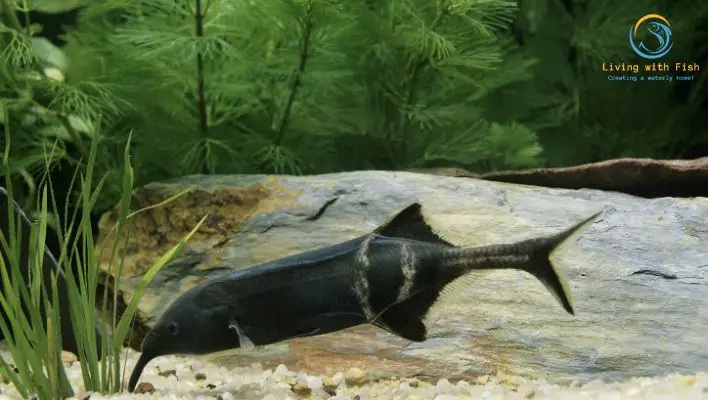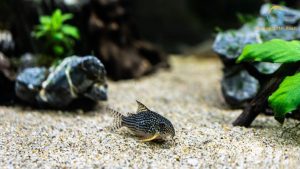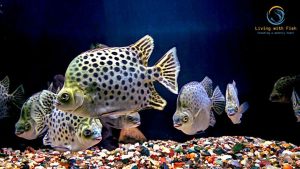This article covers the following areas –
- Why Go for the Oddballs?
- A Selection of My Favorite Oddball Fish for Aquarium
- Care and Maintenance for the Oddballs
- Wrapping Up

Ever stood before an aquarium and thought, “I’ve seen this before”? I’ve been there. While there’s nothing wrong with the classics, a whole world of quirky, unusual, and downright fascinating fish species will raise an eyebrow or spark a conversation.
“Oddball fish” refers to aquarium species that deviate from conventional fish types in appearance, behavior, or habitat needs. These unique aquatic inhabitants include the Elephant Nose Fish, Axolotl, Vampire Tetra, and Mandarin Goby.
Dive deeper to discover the captivating world of these aquatic wonders. From their peculiar features to their intriguing behaviors, each fish presents a story waiting to unfold. Continue reading to understand their care requirements, habits, and the magic they bring to a home aquarium.
Why Go for the Oddballs?
In the vast, mesmerizing world of aquariums, it’s easy to gravitate towards the familiar. Maybe you remember those guppies from a childhood friend’s fish tank or the ever-present goldfish from countless fairs. Yet, for those with a dash of daring and a sprinkle of curiosity, the allure of the ‘oddball’ fish is irresistible.
Wouldn’t it be captivating to have your friends and family huddled around your aquarium, eyes wide, asking, “What on earth is that?”
The Thrill of the Unique
Ah, the allure of the unconventional! Choosing an oddball fish isn’t just about having something different in your tank. It’s about embracing a sense of wonderment. When most aquariums have the usual suspects, going the oddball route is like introducing a delightful wildcard.
These oddballs, with their peculiar shapes, colors, and behaviors, can become the crown jewel of your collection. Picture the fascinating Leaf Fish that mimics a dead leaf floating in the water or the upside-down swimming of the African Butterfly Catfish. Each oddball species offers a novel spectacle, turning every glance at your tank into an exploration.
Beyond Aesthetics: Understanding Their Worth
“Wow, that fish looks cool!” Yes, it’s a common reaction. But the true value of oddball fish goes much deeper than their exterior. Many of these species have adapted to very specialized niches in their natural habitats.
For instance, the Arowana, often called the ‘water monkey’, can jump out of the water to snatch insects. You get a front-row seat to these evolutionary marvels by bringing them into your home.
And as you dive deeper into their stories, you start understanding the ecological balance they maintain in the wild. This can spark crucial conversations about conservation and the importance of biodiversity.
A Conversation Starter
We’ve all had those awkward silences when guests visit. But if there’s an oddball fish in your living room, there’s no room for mundane small talk. Your tank becomes the epicenter of curiosity and fascination. “Is that fish actually glowing?” a friend might ask, pointing at the bioluminescent Dragonet.
Or they might be intrigued by the peculiar way your Mantis Shrimp uses its powerful claws. You’ll find that these oddballs can trigger tales of evolution, survival, and the wonders of aquatic life, making every gathering an enlightening experience.
Expanding Your Fish-Keeping Skills
Venturing into the world of oddball fish isn’t just about aesthetics; it’s a delightful challenge for hobbyists. These unique species often come with specific care requirements. With its beady eyes and round body, the adorable Pufferfish might need a particular diet or water condition.
As you cater to these needs, you’re not just caring for a pet; you’re honing your skills, diving deeper into aquatic biology, and expanding your understanding of diverse ecosystems. It’s a continuous journey of learning, adapting, and growing, making the art of fish-keeping a more enriching experience.
In essence, embracing the unusual in the world of aquariums is a journey packed with wonders. You’re not just adding a fish but tales, lessons, and a dash of the unexpected to your daily life. Why stick to the script when you can write your own adventurous fishy tale?
A Selection of My Favorite Oddball Fish for Aquarium
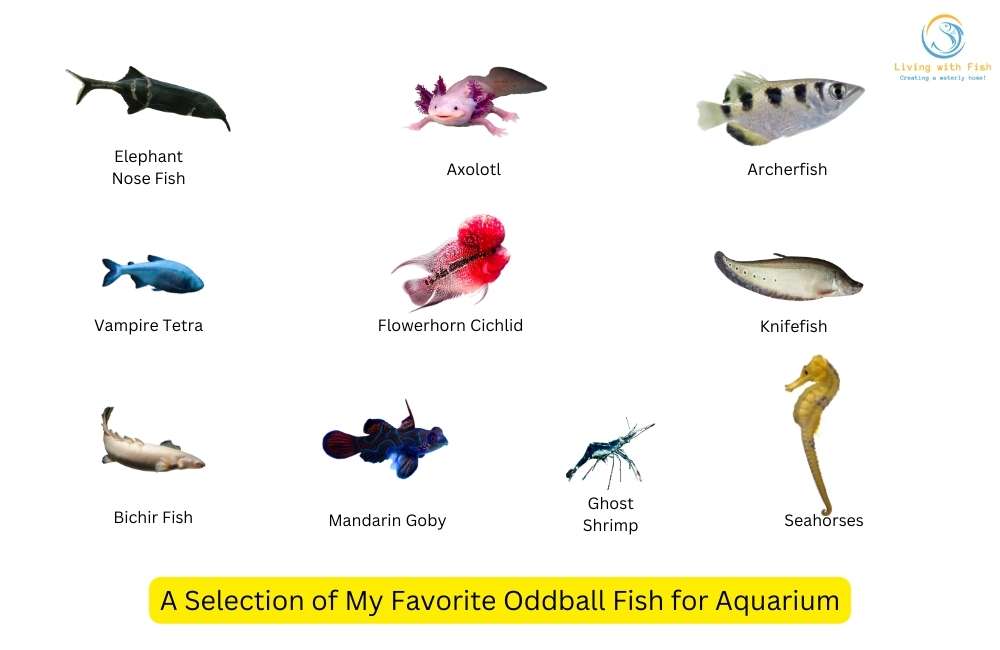
If the world of fish were a canvas, then oddball fish would be the splashes of bold color that draw your eye and capture your heart. These aren’t just your average, run-of-the-mill fish. These fish make you stop, stare, and invariably ask, “What is that?” Each species comes with its own quirky traits and fascinating backstories. Ready for a tour of my personal underwater wonderland? Here’s a roundup of some of my absolute favorites that never fail to spark interest and evoke a sense of awe.
1. Elephant Nose Fish
When you first glance at the Elephant Nose Fish, you can’t help but do a double-take. This freshwater oddity, hailing from the murky waters of West and Central Africa, looks like it’s borrowed the trunk of an elephant and the body of a fish to create a quirky and endearing fusion. This “trunk,” scientifically called a proboscis, isn’t just for show. It is a sophisticated tool, detecting electrical signals from potential prey and navigating its dim natural habitat.
What’s even more fascinating? These fish can actually communicate with one another using electrical pulses. Watching them in a tank setting can be a true delight. They’ll often be seen scouring the bottom for food, their proboscis ever-active, making them an engaging species to observe.
2. Axolotl
Stepping into the realm of amphibians, the Axolotl, or the Mexican walking fish as it’s sometimes called, is a wonder of nature. Native to a few lakes in Mexico, their neotenic nature sets axolotls apart.
In simpler terms, while most amphibians undergo metamorphosis from larvae to adults, axolotls skip this step, retaining their water-bound juvenile features throughout their lives. Those frilly gills on the side of their heads? They’re not just ornamental but vital for breathing underwater. And there’s an almost childlike curiosity to them. If you place your face close to the tank, don’t be surprised to find an Axolotl inching closer, its lidless eyes observing you just as keenly as you are it.
And let’s not forget their regenerative abilities. From limbs to parts of their heart, they can regrow it all, making them a fascinating subject of scientific research.
3. African Butterfly Fish
A serene beauty that’s always on alert, the African Butterfly Fish perfectly captures the essence of both its namesakes. Native to the still waters of African swamps and rivers, this fish hovers near the water’s surface, its large wing-like fins spread out and ready for action.
Their upward-facing mouth, equipped with sharp teeth, is perfectly evolved for snatching unsuspecting insects that stray too close to the water. But it’s not all about hunting; these fish also showcase interesting social behaviors. If you have more than one in a tank, you might witness occasional bouts of territorial disputes, a dance of fin and flair.
Yet, for all their surface activity, they rarely venture to the depths, making them a unique fish to observe and a testament to the diversity of aquatic life.
4. Archerfish
Nature’s very own sharpshooter, the Archerfish, brings a blend of precision, power, and playfulness to any aquatic setting. These fish, found primarily in the mangroves and estuaries of Southeast Asia and Australia, have developed a hunting technique that’s nothing short of genius.
They target land-based insects and other small creatures by spitting a jet of water at them, causing the unsuspecting prey to fall into the water and become the Archerfish’s next meal. It’s a sight that’s bound to captivate any onlooker.
In the confines of an aquarium, many Archerfish enthusiasts often engage in playful targeting games, placing small insects or feed above the water’s surface and watching the fish showcase its impeccable aim. Additionally, their social nature means they often enjoy the company of their kind, turning the tank into a lively, action-packed playground.
5. Vampire Tetra
You’d be forgiven for thinking the Vampire Tetra was plucked straight out of a gothic horror story. Originating from the turbulent waters of the Amazon Basin, these creatures boast long, sharp fangs that can send shivers down anyone’s spine.
These fangs, however, aren’t for the faint-hearted; they’re specifically designed to clamp onto their prey. It’s not all intimidation, though. Beyond their fearsome facade lies a fish of elegance and speed. Their streamlined bodies allow them to dart through the waters, providing viewers with an aqua ballet of sorts. While they might not be your typical pet, for those who appreciate nature’s diverse forms, the Vampire Tetra is an intriguing pick.
6. Flowerhorn Cichlid
When Mother Nature decided to go all out with her paintbrush, the Flowerhorn Cichlid resulted. This vibrant and vivacious fish is a visual delight and an aquarium enthusiast’s dream. The prominent hump on their heads, known as a “kok,” is often seen as a sign of good luck in many cultures. But it’s not just their appearance that sets them apart.
These fish are known to have distinct personalities. Some are playful, some more reserved, and others, well, a tad grumpy. It’s like having a little water-bound dog; they might even recognize their caregivers and respond to them. No wonder they’ve taken the aquarium world by storm!
7. Knifefish
Smooth, silent, and spectacularly unique, the Knifefish is like the phantom of the aquarium. Their elongated, knife-like bodies give them a sleek appearance, and the way they move—almost hovering—adds to their mystique. But what’s most intriguing about these creatures is their communication method.
Residing in the dim waters of South America, they rely on electrical fields to “talk” and navigate. For those who enjoy a touch of the mysterious, the Knifefish is the perfect addition, offering both beauty and brains in a singular package.
8. Bichir
Ever fancied having a piece of prehistory in your living room? The Bichir gives you precisely that. Often called “living fossils,” these ancient-looking fish have been around for ages, with a lineage tracing back to the dinosaurs. Their bodies blend segments, ridges, and scales, presenting a rugged yet captivating look.
But their beauty is not just skin-deep. Bichirs are known to be hardy and adaptable, able to tolerate various water conditions. They also showcase a range of behaviors, from leisurely prowls at the tank’s bottom to occasional ventures to the surface for a gulp of air. Owning a Bichir is like owning a moving artifact, a living testament to nature’s enduring and evolving magic.
9. Mandarin Goby
Picture a canvas painted with swirls of blue, orange, green, and everything in between. Now, imagine that canvas swimming around gracefully in your tank. That’s the Mandarin Goby for you! This small, saltwater fish is a favorite amongst aquarists, not just because of its captivating colors, but also its graceful, almost meditative swimming patterns.
However, don’t let their serene nature fool you. They have a penchant for live foods, especially copepods, and ensuring they get a balanced diet can be quite a task. But the effort is all worth it when you see this living artwork adding vibrancy and color to your underwater sanctuary.
10. Ghost Shrimp
If you’ve ever wished for an aquarium companion that’s a master of disguise, then the Ghost Shrimp is your answer. These tiny, almost see-through critters look like they belong in a sci-fi movie. It’s fascinating to observe them, especially when they’re munching on food, as you can often see it passing through their translucent bodies.
Besides their cool, ghostly appearance, they’re also industrious little cleaners, scavenging for uneaten food and algae. This makes them intriguing to watch and beneficial for your tank’s ecosystem. It’s a win-win with these phantom shrimp around!
11. Seahorses
Ah, the seahorse! Nature’s quirkiest and perhaps most enchanting creation. Just watching them is therapeutic. With their upright posture, horse-shaped heads, and curled tails, they’re nothing like your typical fish. Each one carries a unique pattern, making them the fingerprints of the aquatic world. But it’s not just about their looks.
Their behaviors are equally captivating. From how they anchor themselves to plants and corals using their prehensile tails to the male seahorses carrying and birthing the young, every aspect of their life is a marvel. Plus, witnessing their graceful dances and tail twirls with their partners makes you realize that romance is not just a human prerogative! If you’re looking for a touch of wonder and magic, adding seahorses to your tank is a decision you’ll never regret.
There you have it, a deep dive into my enthralling world of oddball favorites. Each one, with its quirks and characteristics, brings a distinct flavor to the aquatic tableau. So, if you ever feel the urge to break away from the norm, you know where to look!
Care and Maintenance for the Oddballs
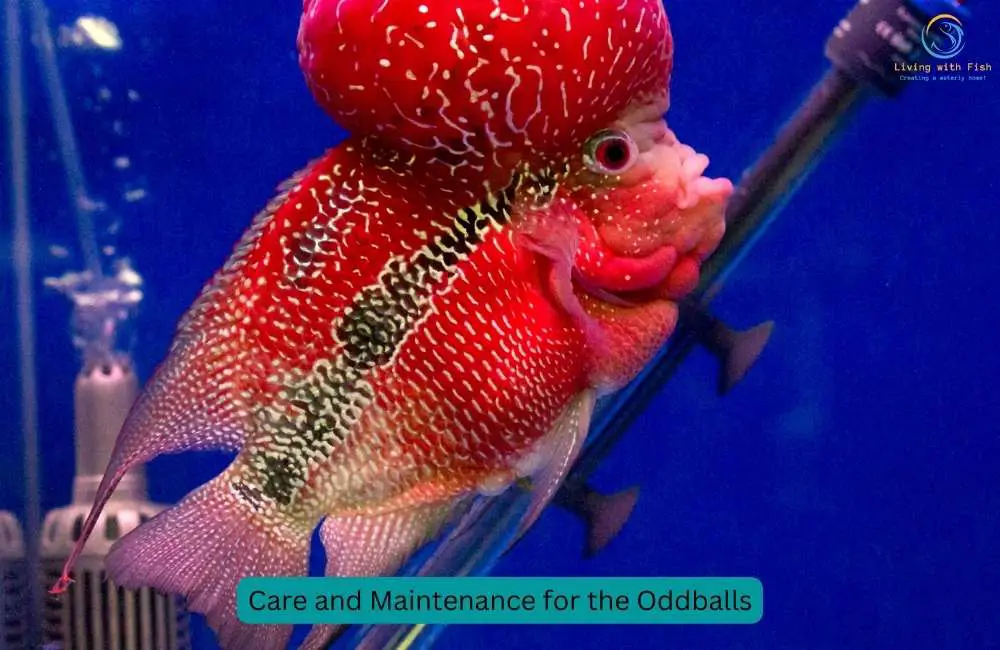
So, you’ve decided to walk on the aquarium world’s wild side. Bravo! But with great fishy fun comes great responsibility. The thing about our beloved oddballs is that they’re not just odd in looks; their care requirements can sometimes be peculiar, too.
But hey, didn’t we sign up for a unique experience? While these lovely underwater eccentrics might require more attention and tailored care, the rewards – in the form of their intriguing behaviors and mesmerizing beauty – are absolutely worth it. The key? Knowledge and preparation. Let’s dive into some must-know tips to ensure your offbeat finned friends lead a happy, healthy life.
Understanding Their Natural Habitat
When we invite these aquatic wonders into our homes, we’re essentially promising them a slice of the world they’re familiar with. By understanding their natural habitat, we can recreate conditions that mimic their wild homes, making them feel safe and allowing them to exhibit natural behaviors.
Elephant Nose Fish naturally inhabit the murky rivers of West and Central Africa. They have evolved to navigate these dark waters using electric fields. In a home aquarium, they would appreciate soft, acidic waters. Moreover, because they’re accustomed to dim environments with ample hiding spaces, incorporating caves and densely planted areas is essential to their well-being.
Axolotls, on the other hand, hail from the chilly mountain lakes of Mexico. Their aquatic home is cool, with the lakebed scattered with rocks and debris. They need colder water in a captive setting, ideally between 60-64°F (15-18°C). Providing a soft substrate, like fine sand, ensures they don’t ingest anything harmful while feeding.
Diet – No One Size Fits All
“Let food be thy medicine,” said someone very wise. In the world of aquatics, this couldn’t be more accurate. What our finned friends consume doesn’t just affect their health, but also their mood, coloration, and behavior.
Archerfish are remarkable hunters, spitting water at terrestrial insects. Mimicking this in a home aquarium setting can be an exciting endeavor. Providing them with a diet of insects isn’t just about nutrition and stimulating their natural hunting instincts.
Mandarin Gobies are picky eaters, to say the least. In the wild, they feast on tiny critters, particularly copepods. Captive Mandarins often prefer live foods, making them challenging for those unprepared for such specialized care.
Picking the Right Tank Mates
Think of your aquarium as a tiny underwater society. Like any community, harmony between members is crucial for peace and balance.
Vampire Tetras can be quite docile despite their fangs and somewhat fearsome names. However, owing to their predatory nature, they might view smaller fish as a potential snack. Therefore, it’s wise to house them with mid to large-sized tankmates.
Flowerhorn Cichlids come with a personality that’s often too big for their tank. Known for their territorial nature, they can be aggressive, especially during breeding. For many aquarists, keeping them solo becomes the best way to avoid conflicts.
Keeping an Eye on Health
Every fish, no matter how unusual, has its set of vulnerabilities. Awareness of these can help in early detection and prevention of potential health issues.
The delicate Axolotls, with their feathery gills, can be prone to fungal infections, especially if water quality deteriorates. Regular water changes and monitoring for signs of distress can go a long way in ensuring their well-being.
With their sensitive, trunk-like extensions, Elephant Nose Fish are prone to injuries. A well-thought-out tank, devoid of sharp or rough objects, can prevent potential harm.
Mimicking Natural Behaviors
If we wish our aquatic pets to feel truly at home, we must recreate scenarios where they can behave just as they would in the wild.
The surface-dwelling African Butterfly Fish naturally seeks shelter amongst floating river vegetation. In a tank, floating plants can provide this much-needed refuge, giving them a sense of safety.
Knifefish are creatures of the night. In their natural habitats, they come out under the cover of darkness. Offering them a dimly lit environment or periods of subdued lighting can encourage them to be more active and feel at ease.
Regular Maintenance and Monitoring
Every fish parent knows this – an aquarium isn’t a set-it-and-forget-it deal. Regular upkeep is the key to a thriving aquatic environment. Ensuring the water quality is optimal, equipment is functioning correctly, and the overall health of the tank’s inhabitants is vital. With oddball fish, it’s even more crucial, as they often have specific needs.
Monitoring water parameters, regular cleaning, and timely equipment checks ensure our unique finned friends have a stable and comfortable environment to thrive in.
In essence, catering to the unique needs of oddball fish might sound like a task, but with the right knowledge and a sprinkle of dedication, it becomes a rewarding journey. After all, watching them flourish and exhibit their natural behaviors right in your living space? Priceless.
Wrapping Up
Aquariums aren’t just about housing fish; they’re about creating a piece of the aquatic world within our living spaces. By choosing oddball fish, enthusiasts challenge their skills and embark on a fascinating journey of discovery.
These unusual species, with their diverse behaviors, forms, and requirements, remind us of the vast and wondrous diversity of life on our planet. It’s essential, however, to remember that while they offer an exciting departure from the norm, they come with specific care needs.
In embracing these beautiful oddities, aquarists get a unique visual treat and the reward of witnessing the natural world’s quirks and wonders up close.

